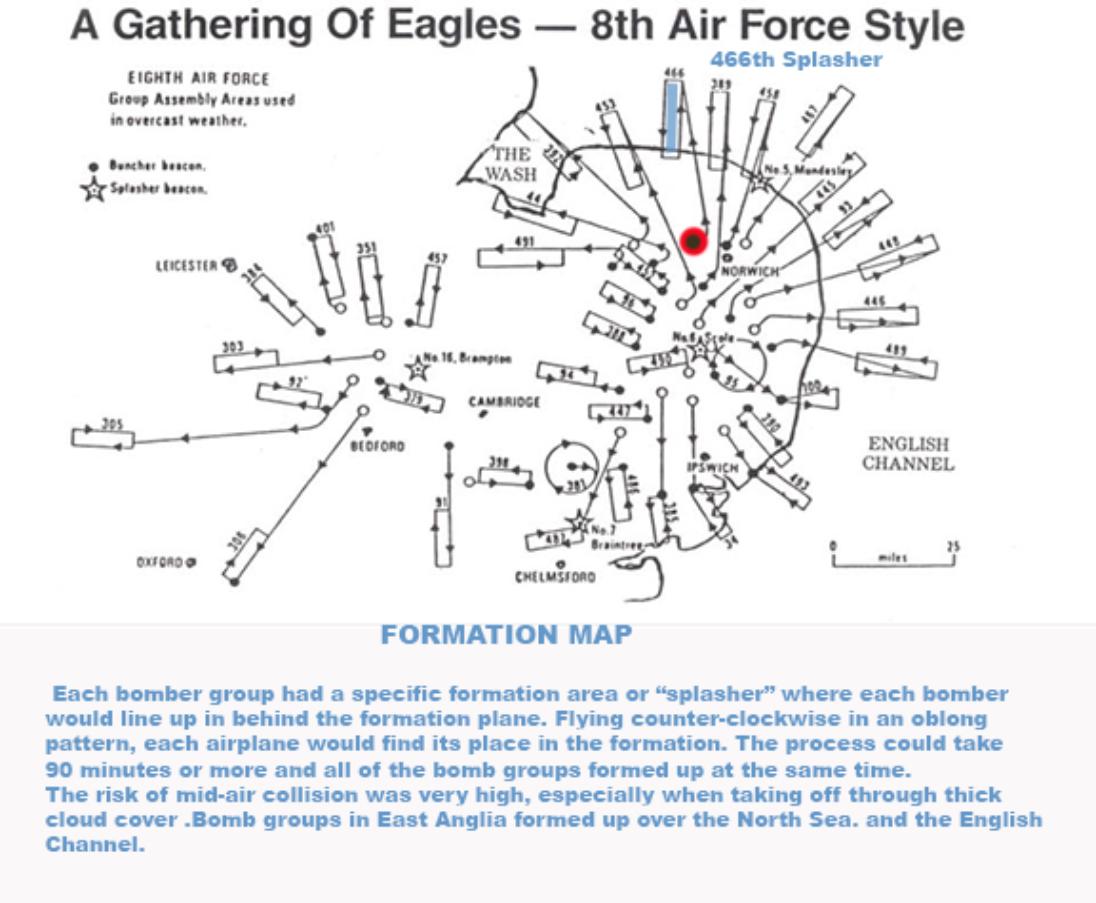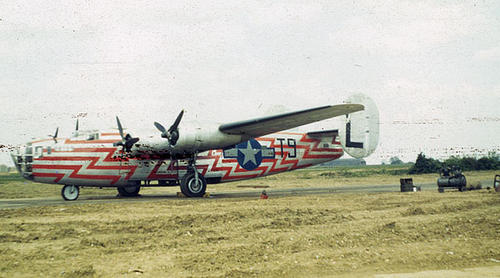80th Anniversary Celebration
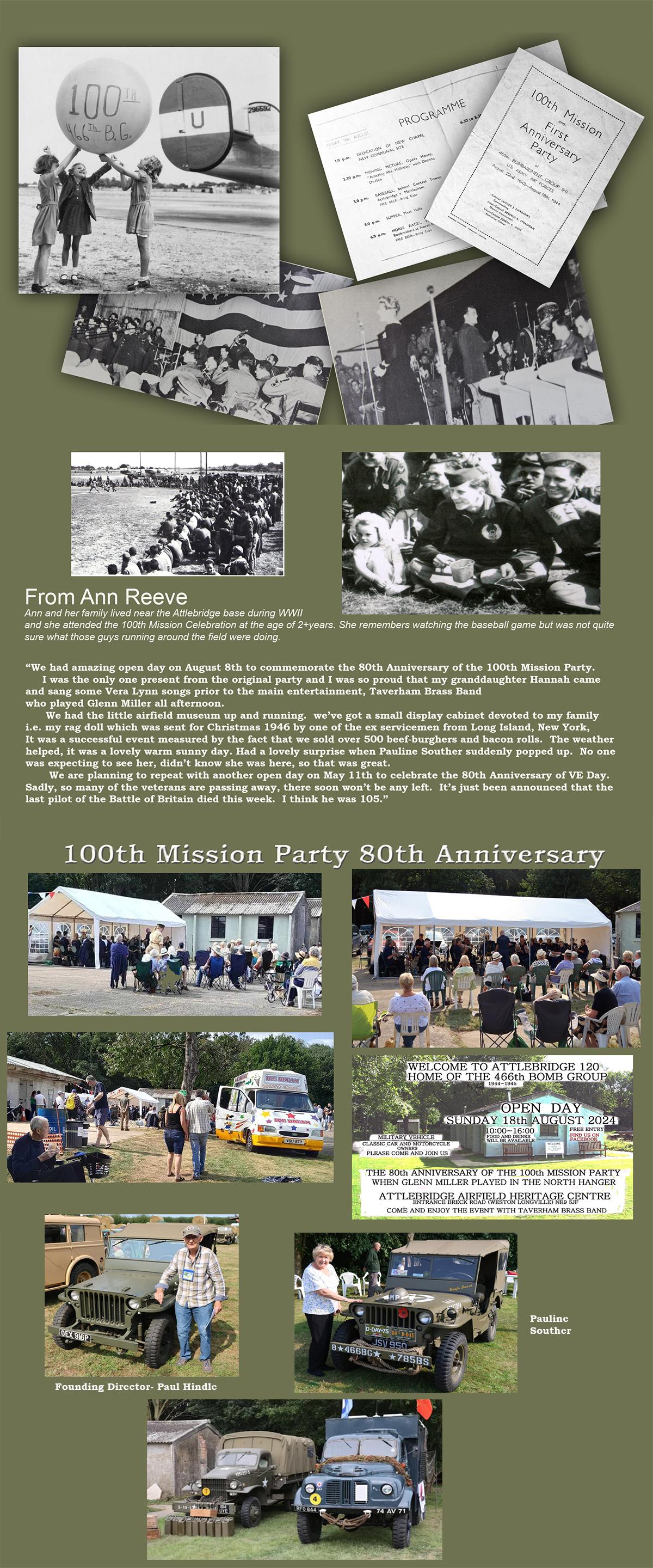
2024 466th Bomb Group Assn. 2024 Treasurers Report
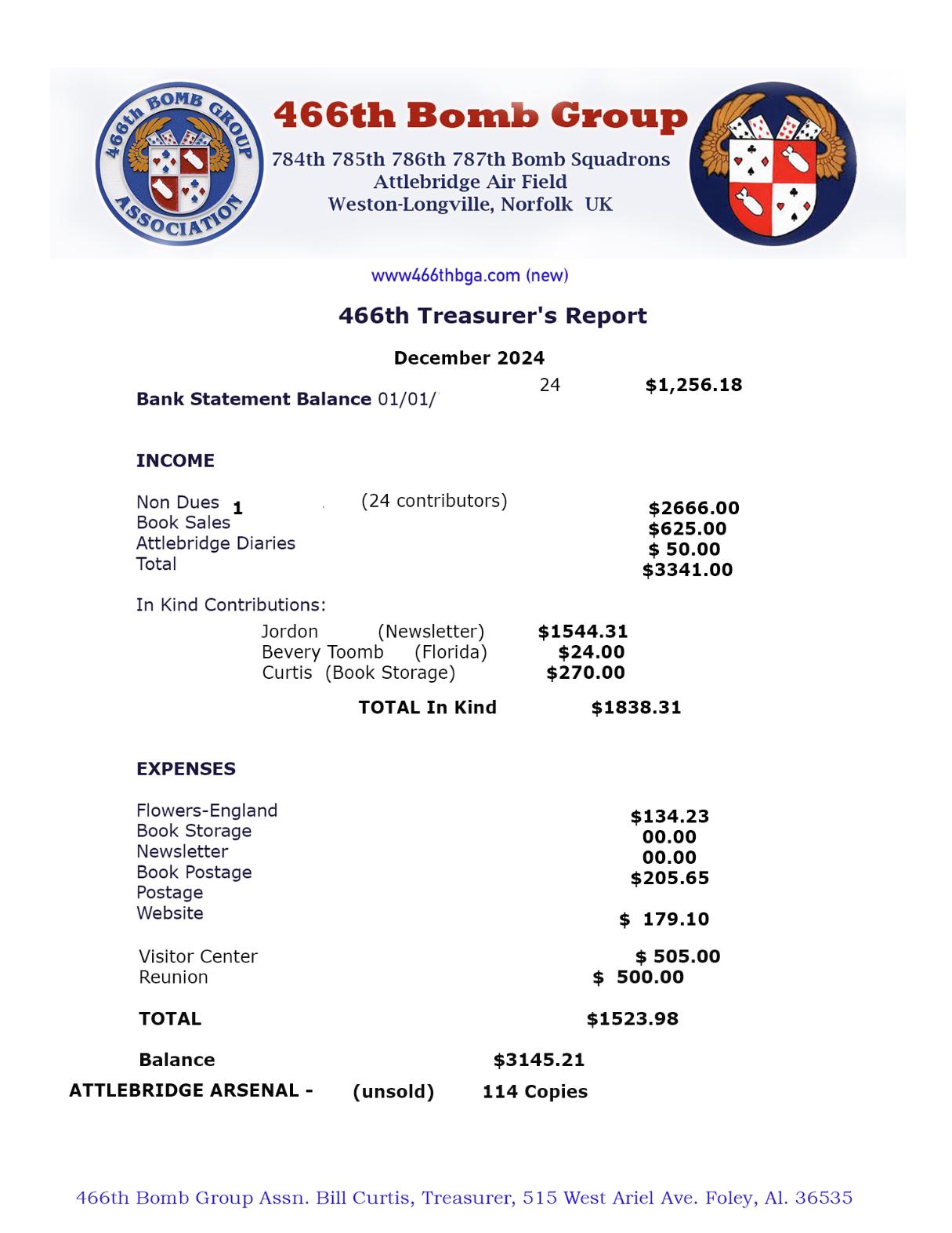

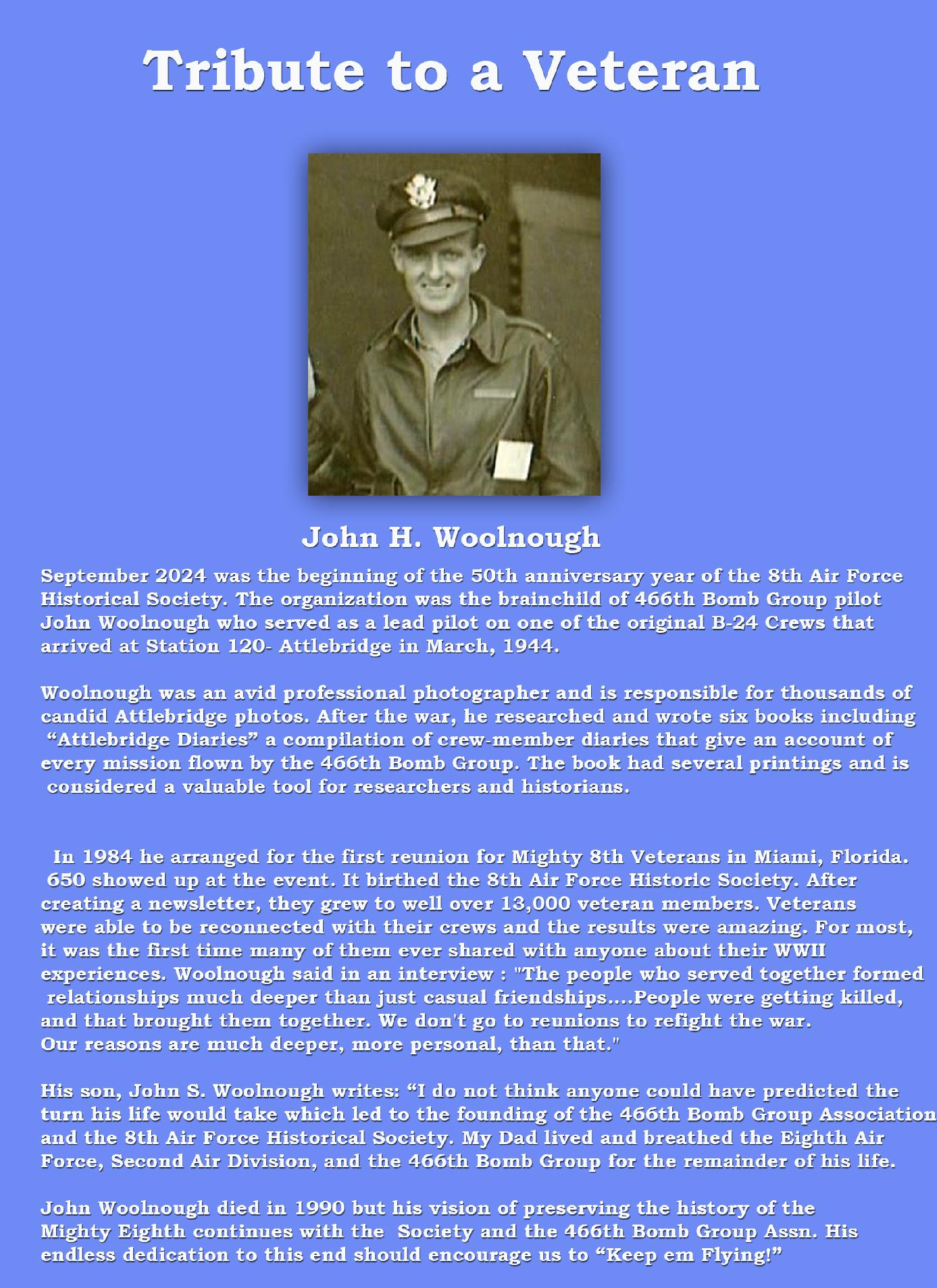
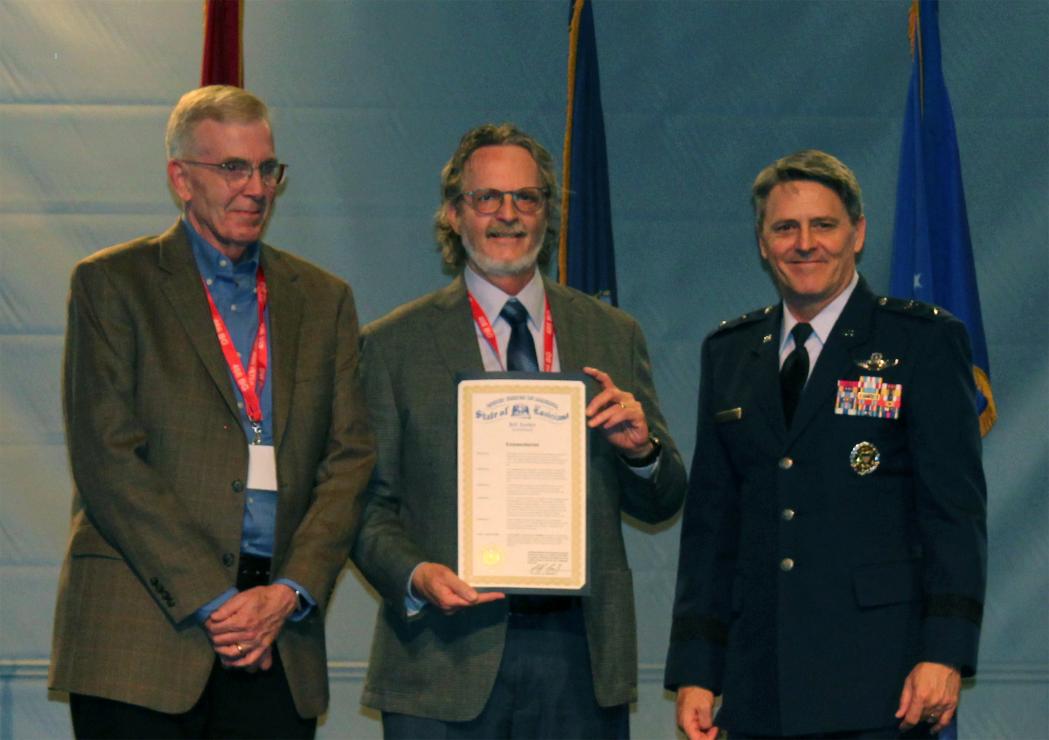
At the 2024 8thAFHS Reunion in New Orleans, John H. Woolnough was honored for his role in the formation of the Historical Society. Receiving the honors from Major General Jason R. Armagost- Commander 8th Air Force were his sons Mark and John S. Woolnough.
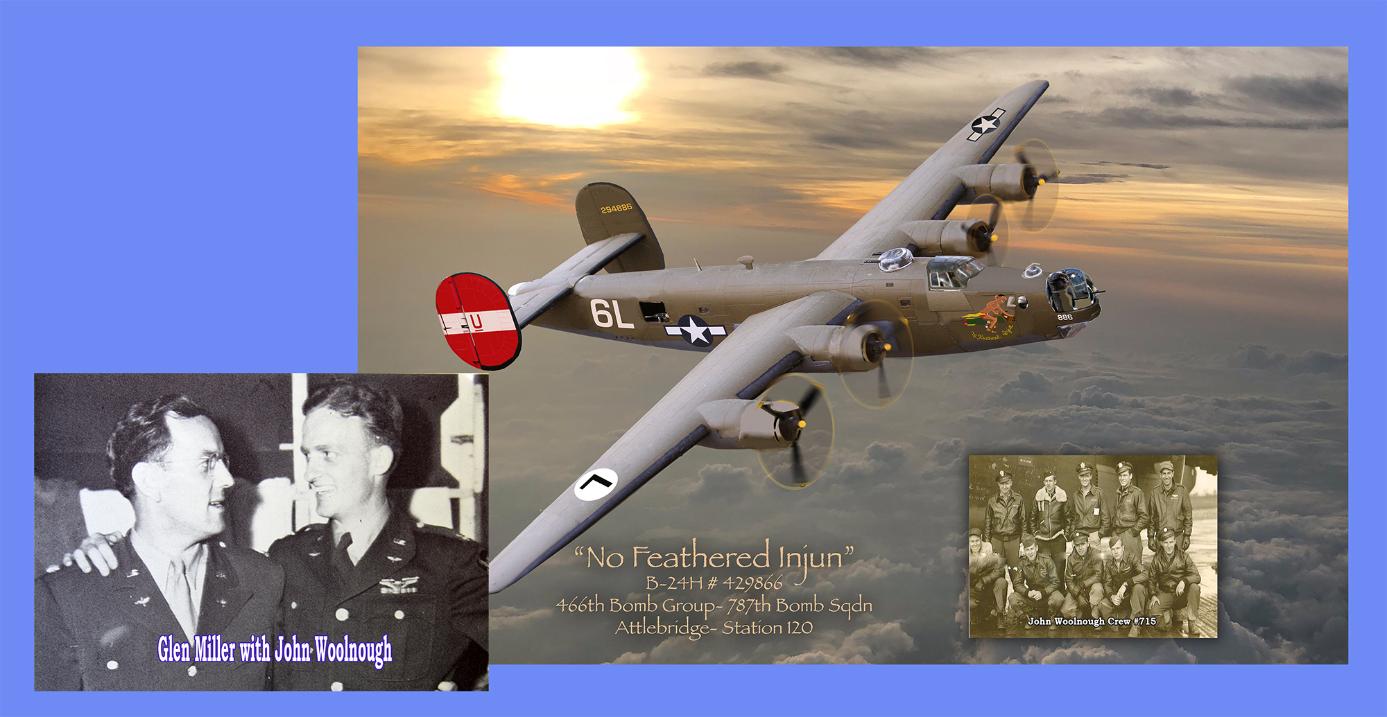
This photo of John with Glen Miller at the 100th Mission Party was always a source of amusement. If you look at the background, you will see plumbing fixtures. The picture was taken in the men's Latrine

466th Bomb Group Formation Ship

SEE MORE INFORMATION BELOW
LOOKING FOR THE THIRD GENERATION
In around 2006 the 8th AF Historical Society began the Next Gen. Appeal to encourage children of 8th AF Veterans to carry on the responsibility of keeping the organization and its mission to preserve and educate new generations about our WWII Veterans. The 466th Bomb Group Association recruited from among the children of our veterans to join and keep the work of the Association going. We are now at a point when we, as children of the vets are getting older and we need to encourage a next generation of sons and daughters to join with us. Please consider getting your children and grandchildren on our subscription list for the newsletter. We do ask for a $20 annual donation to cover expenses.
We Thank you for your support! Bill Curtis, Treasurer
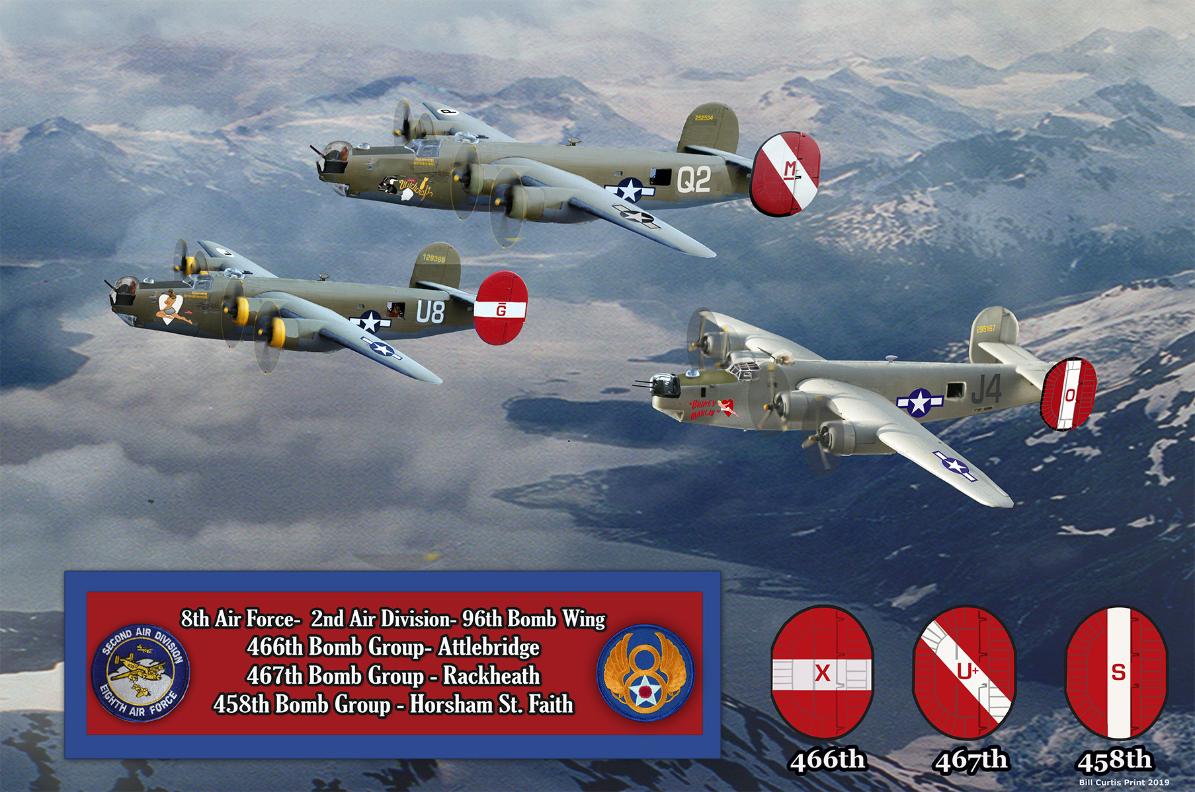
2nd Air Division 96th Bomb Wing
was made up of three bomb groups who formed up
together for combat missions.
The RED tail fins were for easy identification
TAIL FIN PAINT SCHEMES
B-24 Groups in 2nd Air Division
These paint schemes were adopted April 15, 1944 (see below)
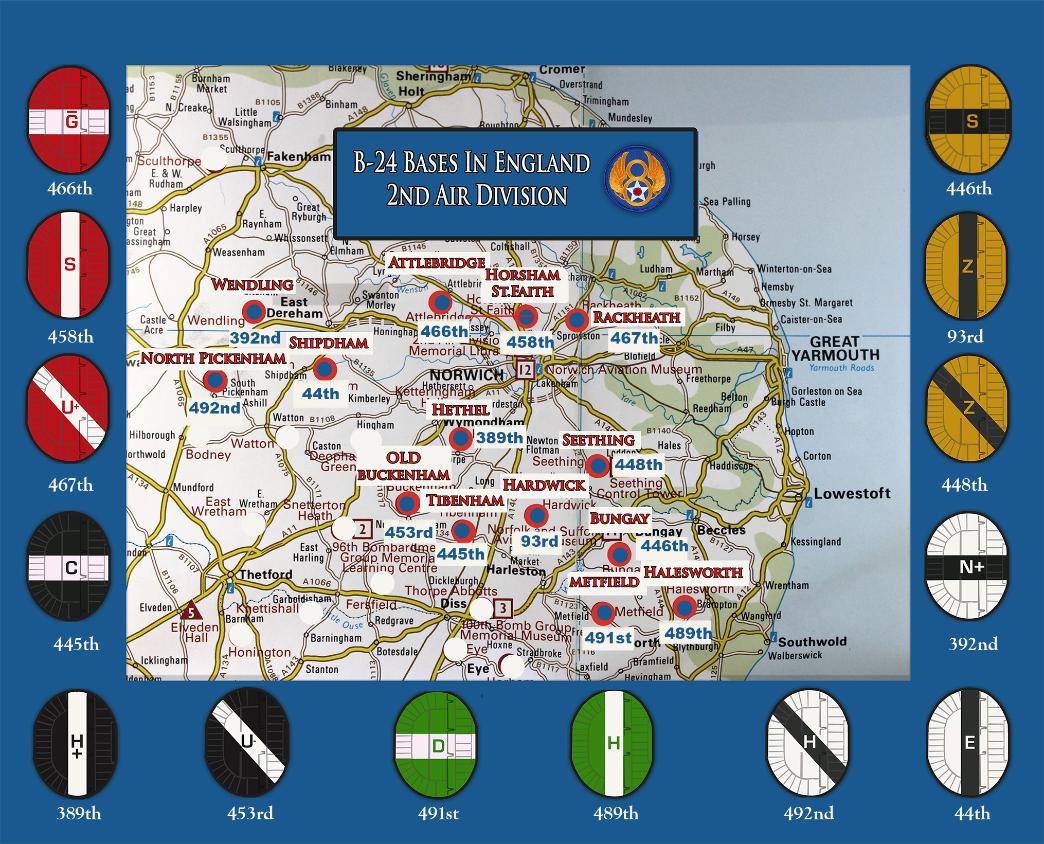
8thAFHS DVDS AVAILABLE

Please donate to the 466th Visitor Centre Project
via Pay Pal : minnie160178@gmail.com
See the weekly updates on the building progress
at https://www.facebook.com/466historian/?fref=ts
PLEASE DONATE TO THE EFFORT!
"Just the Facts, Mam"
Question?
Why did they have to dry the parachutes after every mission?
After returning from each mission all crews would drop off their parachutes to a large Nissan Hut to be dried out. Since the environment was so cold at the altitudes they were flying -30 -40 degrees F any moisture left in a parachute would turn into ice crystals that were sharp enough to cut strips in the parachute canopies when they were deployed, rendering the parachutes useless.
To DITCH or Not to Ditch
Pilots returning from a bombing mission with a damaged aircraft had a difficult decision to make as they approached the coastline to cross the North Sea. The B-24 was almost impossible to ditch in the ocean.The high Davis wing gave no buoyancy and the aircraft tended to break in half on impact and sink immediately. Another problem that came up was that the large life raft in the airplane would inflate but it was attached to the airplane by a heavy strap, which couldn't be released without cutting it with a knife. Consequently it was usually pulled to the bottom when the aircraft went down. Many 466th Crews were lost in the cold waters of the North Sea. Their names are recorded on the Wall of the Missing at the American Cemetery in Cambridge
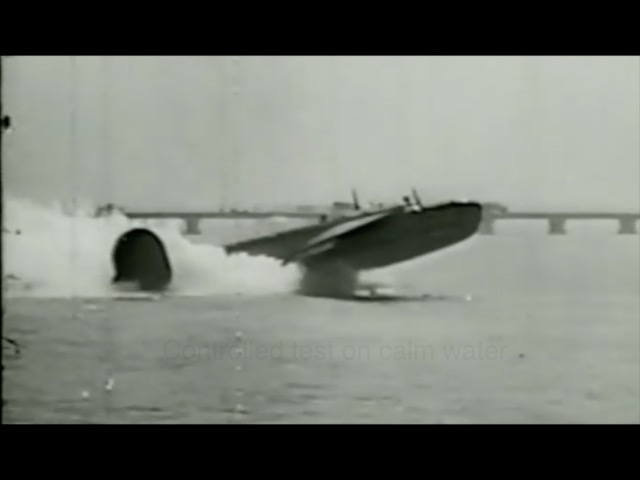

CORRESPONDENCE
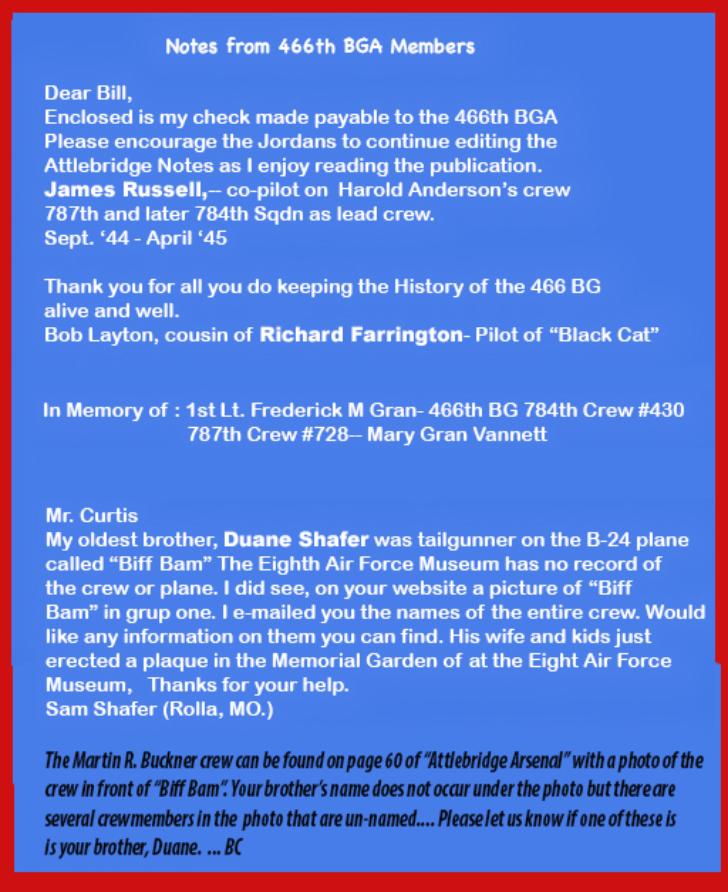
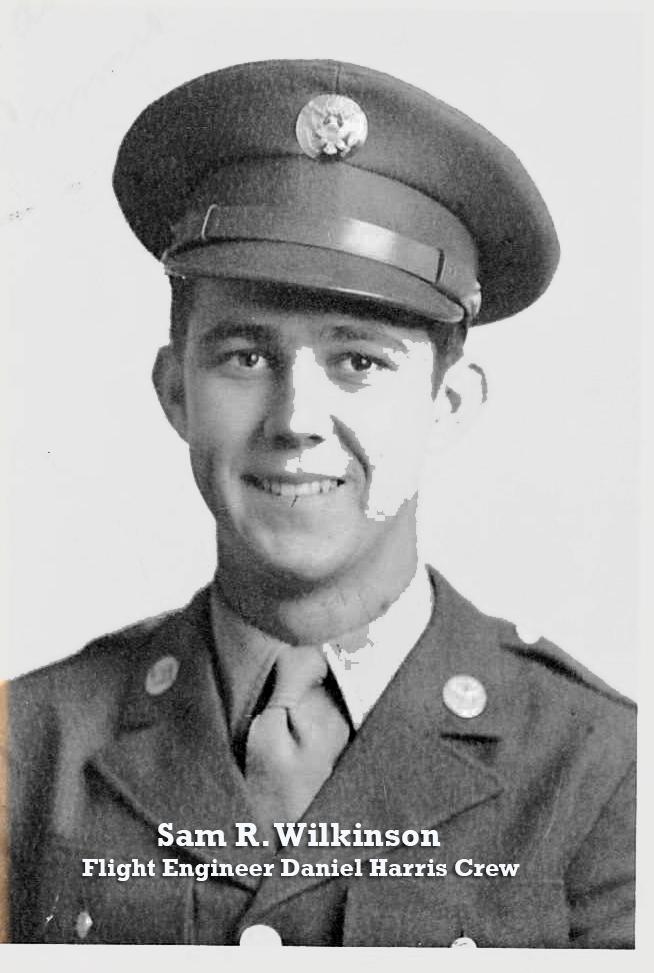
I received a note from Larry Wilkinson who's father Sam R. Wilkinson was the nose gunner on the Daniel Harris Crew #717. They were shot down on April 8, 1944. It was only their 4thmission and and a costly mission for the the 466thwith a loss of 6 aircraft and 60 men. Sam survived the mission with 9 others from his crew and spent the next 13 months as a POW in Stalag Luft XVIIb. Waist Gunner, Eldon Slager was killed on the first wave of ME-109's
Attlebridge Diaries accounts describe the mission:
“They don't come any harder that the one we flew today to Brunswick The Jerries threw everything they had at us, fighters and flack. It was the big “maximum effort” raid our operations had long predicted”Clade Meconis (CP Dike Crew #504)
From Attlebridge Arsenal:
John Bushing who was the flight engineer on the Harris Crew wrote:“Our aircraft was hit by cannon and machine gun fire. The #2 engine suffered a direct hit. We had an intense fire in the bomb bay and fell from formation with a rapid loss of altitude. We dumped the bombs which diminished the fire somewhat. I extinguished the rest of the fire with the on board fire equipment.”
Bombs Away?
----------------------------------------------------------------------------------------------------------------------------------------------------------------------
Question sent from LIZ:
I am trying to find any information on a particular mission- 27 March 1944 - where a/c was misloaded with multiple 100# bombs and several hung up and did not release. This happened on my father's crew and they had to be removed and repositioned by hand onto another shackle so they could be safely individually dropped. Did this happen to anyone else?
I put out the question on our Facebook site & the Army Air Forces Forum and Veteran Ralph Lynn replied:
"Bill,It was not uncommon for bombs to hang up. I think frigid temperatures was one reason. It happened at least once on our plane. Crew members would kick the bombs loose. Others would use a screwdriver to pry the bomb loose from the offending shackle. Sometimes the pilot would try to shake the bomb loose. However, I never heard of moving a bomb from one shackle to another. And as you noted, Bill, crew members had to try the various methods of dislodging bombs sans parachutes ---- no room for a parachute when you work from a catwalk and narrow spaces between bomb racks.
Ralph
Another Reply from the Army Air Forces 466th Bomb Group Forum:
I can't imagine why they would do this (or even how they would do it). There are 4 bomb racks in a B-24, a pair in the front bomb bay and and 2nd pair in the back bomb bay. The each bomb hooked by two lugs to a bomb shackle and the shackle is hung from two hooks on the "outside" of the bomb rack. When you are standing on the catwalk, say at the front bomb rack, the bomb shackles would be on the "outside" of each rack. For 100 lb bombs, each rack would contain 5 bombs for a total bomb load of 20. If the bottom bomb in the rack did not release, I suppose it is possible that a bomb above it could land on it and not fall. But if you could somehow pull that bomb off the hung bomb, I would think you would just take step our two along the catwalk and then drop it out the bomb bay . Even easier, because of the small size of 100 lb bombs, I would think you could just push the loose bomb off the hung bomb and there would be enough clearance that the bomb would fall free and not hit the outside of the ship. (When a man was working on a hung bomb the bomb bay doors would be open. )
As mentioned above for the hung bomb, I think they would try to kick or pry it free of the shackle and let it fall.
466th Bomb Group Crew Collections and
Airmen's Diaries and Shared Photos
These items belong to veteran families and are posted for historical information only
and we ask that they not be copied for other purposes.
James L. Bruner
was Co-Pilot on the Wallace Clay crew who flew 32 combat missions between May and September, 1947. His collection includes photos and newspaper clippings, as well as a mission list.
W. Robert Wagner
was navigator on the John Garison Crew # 543 and #467. He kept a handwritten notebook with a short description of each mission and also kept newspaper clippings from Stars & Stripes:
JACK DOUGHERTY CREW COLLECTION
The Dougherty Crew arrived in May of 1944 and completed 32 missions by mid-October, 1944. Jack Dougherty had a camera (which was frowned upon) and shot photos and gave copies to his crew members. They flew "Dirty Gertie" with the 786th Squadron.
More Facts---Tail Fin Colors
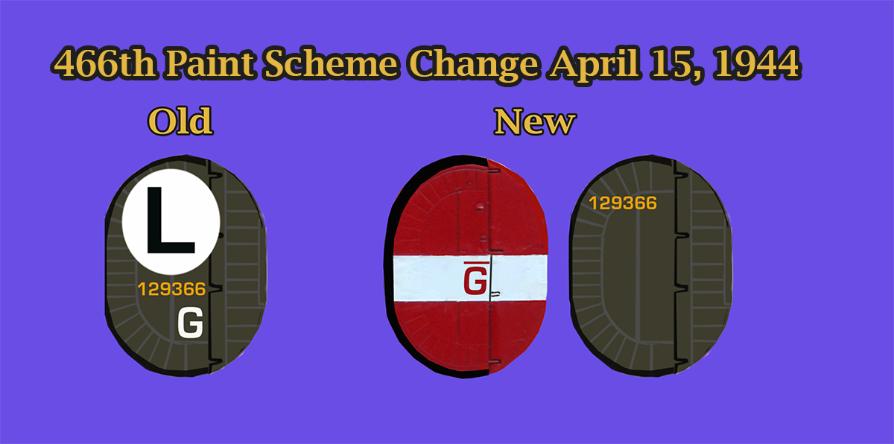
The 466th Bomb Group and Squadron Patches
History of the FLYING DECK
"Attlebridge Diaries" records that in December of 1943 at Alamogordo where the Bomb Group was assembled, there was a contest to come up with a name for the 466th Bomb Group. The $10 prize went to M/Sgt Gerrard Dieffenbach, who was in the Intelligence Branch. He came up with the Group Name "The Flying Deck' with each squadron being named for a suit. 784th- Clubs, 785th Diamonds, 786th-Hearts, 787th-Spades. In addition the crews would be numbered with the numbers of their suit, For instance Crew 715 from the 787th would have a ten and a five of spades-. The group name The Flying Deck was popular but crew designations were never used.
The Bomb Group emblem was later designed in England after another contest was held on base. Fourteen ideas had been submitted and Corporal Ernest Ender's design was chosen.The designs ended up being painted on walls at the base. I don't believe the Flying Deck was made into a patch until post war. The only patches for the squadrons were found after the war 1950's and according to my expert Ralph Lynn, (Co-Pilot, Hayes Crew) who saw one once, were kind of flimsy and it turned out they came from Hollywood and were made for some war movie.
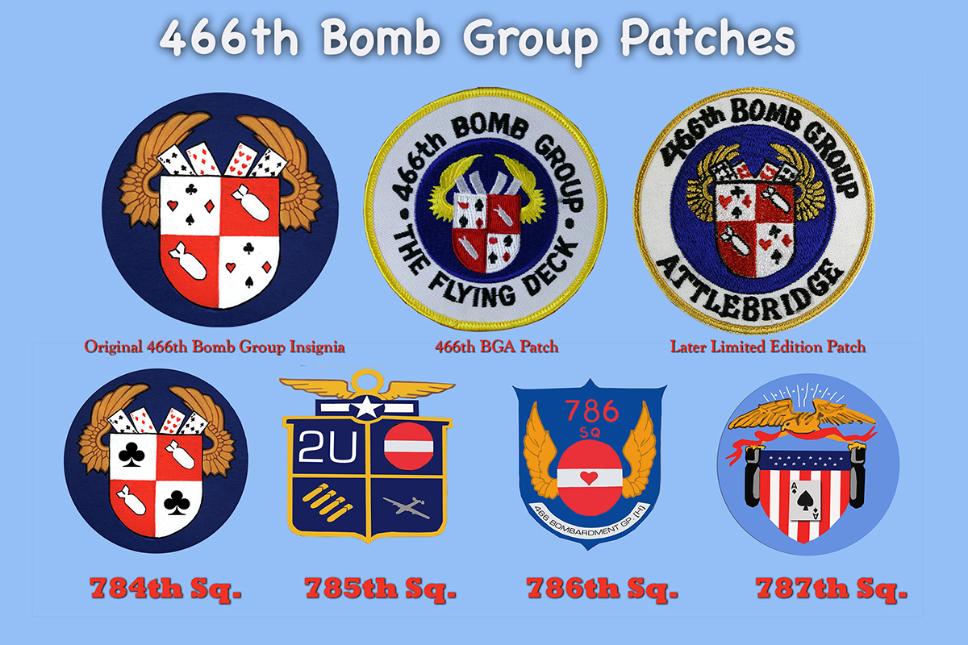
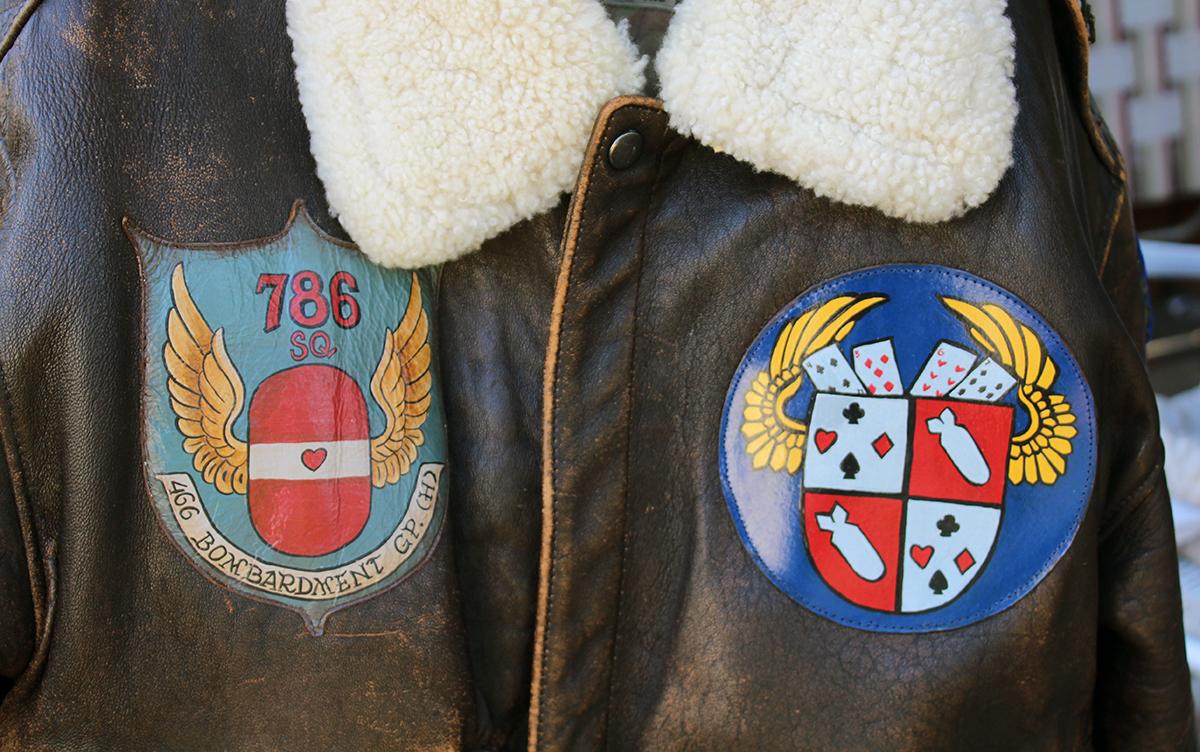
This 786th Squadron Patch was painted by Anneke Helleman of the Netherlands
"READY & WILLING"
466th Bomb Group Formation Ship

This was the "formation ship" for the 466th Bomb Group known as the "Ready and Willing". Some crews referred to it as the "Striped Ass Ape". It was a war weary B-24D that was stripped down of all armor and weapons, and then painted to be easily recognized in the air. Each of the 2nd Division Bomb Groups had its own assembly ship. When the 466th bomb group left on a mission they would fly north to Cromer, along the coastline to an area over the North Sea that was designated "Splasher Five". The Group would fly counter-clockwise in a large circle to get into their bombing formation. The Formation Ship was at the front of the line and all the other B-24's formed up behind. The process took about 90-minutes. At the same time a number of other bomb groups were forming on their own assembly ships in close proximity. There were a number of mid-air crashes during this process. Once the airplanes were all in their formation, The Assembly ships would peel off and return to their bases and the formation would continue on to their target.
Ready & Willing was used for a number of special assignments. It was used to haul the instruments and Glenn Miller's band to Attlebridge for their "100th Mission Party". See photo and the story of that trip below.
According to James Sharp " A great many of these assembly ships were originally with the 93rd bomb group who were the first B 24 group to arrive in England. After being deemed battle weary these B24s became assembly ships throughout southern England"
This particular aircraft was flown out of North Africa on the historic "Ploesti Oil Fields Raid" and survived that costly mission.
FORMATION " ASSEMBLY "
SHIPS
Above was the original paint scheme for Ready & Willing but the tail markings were probably changed two weeks after the 466th's first mission on April 6, 1944. On April 15 all 466th B-24's had the outer tail fins painted red with a white horizontal stripe. The big letter L for the 466th then was painted over the star on the fuselage on the formation ship and was probably lighted to allow easy identification in the dark early mornings of winter, when the red striping could not be seen. All 466th aircraft also had the Circle "L" on the top end of the starboard wing. On the middle of the white stripe of the tail was the red letter "Q" which was part of the radio call sign. Ready & Willing'c radio call sign was "109Q". The SN# of the airplane was 42-14109.
Glenn Miller ORCHESTRA GETS A WHITE KNUCKLE FLYING EXPERIENCE
From "ATTLEBRIDGE DIARIES" 'Fred McConnell remembers that "we flew (the Formation Ship and two other airplanes) down to a fighter strip with 4000 foot runways to bring back Glenn Miller's Band for the party. "We took parachutes and strapped one on each one of the eighteen musicians. We put 6 or 8 on the cat walk (of course we didn't close the doors all the way- they needed air) and my engineer and radio operator carried on about not being able to get off on that short runway. You can imagine with this buildup what happened- A short field take-off with full throttles, straining the brakes. Needless to say we had an excess of flying speed when the Engineer yelled "Oh My Gosh, we ain't going to make it"! About that time the grass went under their feet. The way that B-24 climbed would have done any fighter credit. Had to give one of the trumpet players first aid!'"
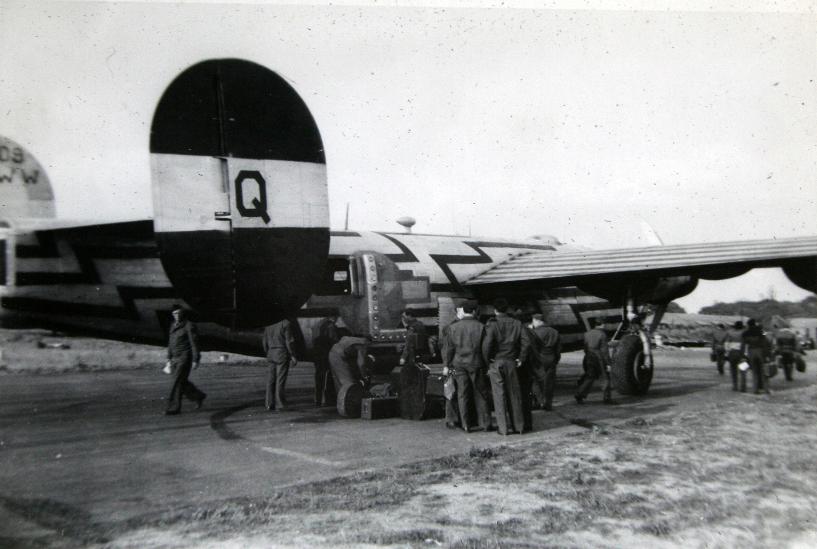
Glenn Miller Band unloading instruments for 100th Mission Party at Attlebridge - photo: Jack Dougherty
THE FORMATION PROCESS
90 minutes of flying in circles at Dawn
